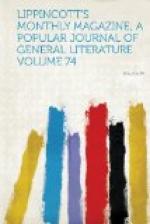a little wildflower from Theodore Parker’s grave
to send home to one of his romantic admirers.
Fiesole must be a very ancient town, for there is
a ruined amphitheatre there, and the remains of walls
so old that they are called Pelasgic in their origin;
which is, I take it, sufficiently vague. The
high hill is composed of the most solid marble; so
the guidebooks say, at least. This is five hundred
and seventy-five feet above the sea, and on its summit
stands the cathedral, very old indeed, and built in
the form of a basilica, like that of San Miniato.
From this hill you look down upon the plain beneath,
with the Arno winding through it, and upon Florence
and the Apennine chain, above which rise the high
mountains of Carrara. Here, on the highest available
point of the rock, I used to sit reading, and looking
upon the panorama beneath, until the sinking sun warned
me that I had only time to reach the city before its
setting. I used to love to look also at works
of art in this way, for by so doing I fixed them in
my mind for future reference. I never passed
the Piazza della Signoria without standing some minutes
before the Loggia dei Lanzi and the old ducal palace
with its marvelous tower. Before this palace,
exposed to the weather for three hundred and fifty
years, stands Michael Angelo’s David; to the
left, the fountain on the spot where Savonarola was
burnt alive by the order of Alexander VI.; and immediately
facing this is the post-office. I never could
pass the post-office without thinking of the poet Shelley,
who was there brutally felled to the earth by an Englishman,
who accused him of being an infidel, struck his blow
and escaped.
I made many visits to the Nuova Sacrista to see the
tombs of the two Medici by Michael Angelo. The
one at the right on entering is that of Giuliano,
duke of Nemours, brother of Leo X. The two allegorical
figures reclining beneath are Morning and Night.
The tomb of Lorenzo de’ Medici, duke of Urfrino,
stands on the other side of the chapel, facing that
of the duke de Nemours. The statue of Lorenzo,
for grace of attitude and beauty of expression, has,
in my opinion, never been equaled. The allegorical
figures at the feet of this Medici are more beautiful
and more easily understood than most of Michael Angelo’s
allegorical figures. Nevertheless, I used sometimes,
when looking at these four figures, to think that
they had been created merely as architectural auxiliaries,
and that their expression was an accident or a freak
of the artist’s fancy, rather than the expression
of some particular thought: at other times I
saw as much in them as most enthusiasts do—enough,
I have no doubt, to astonish their great author himself.
I believe that very few people really experience rapturous
sensations when they look at works of art. People
are generally much more moved by the sight of the
two canes preserved in Casa Buonarotti, upon which
the great master in his latter days supported his tottering
frame, than they are by the noblest achievements of
his genius.




